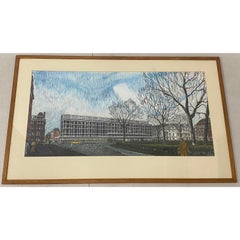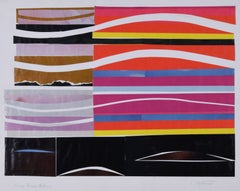Mid-20th Century Mixed Media
Surrealist Mid-20th Century Mixed Media
Archival Paper, Magazine Paper
Impressionist Mid-20th Century Mixed Media
Charcoal, Pastel, Watercolor
Abstract Geometric Mid-20th Century Mixed Media
Tape, Laid Paper
Conceptual Mid-20th Century Mixed Media
Mixed Media
Abstract Mid-20th Century Mixed Media
Magazine Paper
Surrealist Mid-20th Century Mixed Media
Magazine Paper
Modern Mid-20th Century Mixed Media
Modern Mid-20th Century Mixed Media
Paper, Mixed Media
Post-War Mid-20th Century Mixed Media
Lacquer, Oil Crayon, Mixed Media, Oil
Post-War Mid-20th Century Mixed Media
Ceramic, Earthenware
Mid-20th Century Mixed Media
Mixed Media
Art Deco Mid-20th Century Mixed Media
Mixed Media, Gouache
Mid-20th Century Mixed Media
Cardboard
Abstract Expressionist Mid-20th Century Mixed Media
Mixed Media
Abstract Mid-20th Century Mixed Media
Canvas, Paper
Abstract Mid-20th Century Mixed Media
Mixed Media
Contemporary Mid-20th Century Mixed Media
Wood, Found Objects
Surrealist Mid-20th Century Mixed Media
Paper, Board
Abstract Expressionist Mid-20th Century Mixed Media
Masonite, Oil
Abstract Mid-20th Century Mixed Media
Paper, Oil
Mid-20th Century Mixed Media
Paper, Pastel
Abstract Mid-20th Century Mixed Media
Mixed Media
Mid-20th Century Mixed Media
Watercolor, Pencil
Modern Mid-20th Century Mixed Media
Watercolor
Abstract Mid-20th Century Mixed Media
Metal
Abstract Mid-20th Century Mixed Media
Mixed Media, Wood, House Paint
Pop Art Mid-20th Century Mixed Media
Felt, Cord, Plexiglass, Screen
Mid-20th Century Mixed Media
Giclée
Mid-20th Century Mixed Media
Giclée
Mid-20th Century Mixed Media
Giclée
American Modern Mid-20th Century Mixed Media
Pastel, Archival Ink, Gouache, Graphite, Paper
Other Art Style Mid-20th Century Mixed Media
Paper
Abstract Mid-20th Century Mixed Media
Mixed Media, Oil
Abstract Mid-20th Century Mixed Media
Mixed Media, Oil
Abstract Mid-20th Century Mixed Media
Mixed Media, Oil
Mid-20th Century Mixed Media
Paper, Charcoal, Mixed Media, Watercolor, Gouache
Mid-20th Century Mixed Media
Paper
Expressionist Mid-20th Century Mixed Media
Paper, Watercolor, Pen
Modern Mid-20th Century Mixed Media
Canvas, Paper, Mixed Media
Modern Mid-20th Century Mixed Media
Paper, Mixed Media
Minimalist Mid-20th Century Mixed Media
Paper, Mixed Media
Mid-20th Century Mixed Media
Linen
Mid-20th Century Mixed Media
Mixed Media
Other Art Style Mid-20th Century Mixed Media
Lithograph
Mid-20th Century Mixed Media
Crayon, Mixed Media, Oil, Gouache, Board
Modern Mid-20th Century Mixed Media
Mixed Media
Abstract Mid-20th Century Mixed Media
Mixed Media
Mid-20th Century Mixed Media
Watercolor, Gouache
Mid-20th Century Mixed Media
Charcoal
Modern Mid-20th Century Mixed Media
Paper, Glue
Mid-20th Century Mixed Media
Acrylic
Abstract Mid-20th Century Mixed Media
Stone, Slate
Post-War Mid-20th Century Mixed Media
Ceramic, Earthenware
Abstract Mid-20th Century Mixed Media
Paper, Crayon, Graphite
Mid-20th Century Mixed Media
Oil, Pencil
Mid-20th Century Mixed Media
Tempera
Mid-20th Century Mixed Media
Board, Mixed Media
Contemporary Mid-20th Century Mixed Media
Paper, Mixed Media
Surrealist Mid-20th Century Mixed Media
Gouache
Abstract Expressionist Mid-20th Century Mixed Media
Color, Mixed Media, Screen
Read More
Cecilia Vicuña Merges Politics, Science and Spirituality in Her Poetic Art
The Chilean creator, who has been living in exile in New York for decades, is having a major moment, receiving the biggest exhibitions, commissions and awards an artist could dream of.
An Inspiring Collage by Self-Taught Miami Artist Purvis Young
In 1995, the artist embellished a found poster of Martin Luther King with visionary markings.
This Hypnotic Yayoi Kusama Collage Seems to Reach beyond the Canvas
In Repetition GL.A, polka-dotted protuberances rise from a surface of rippling net. Here’s what makes the piece so rare.
In the Late Hung Liu’s Historical Portraits, Layers of Joy and Struggle Are Exposed
We spoke with the artist, in one of her last interviews, about the messages in her striking figurative works, which will be featured in a posthumous show at the National Portrait Gallery.





